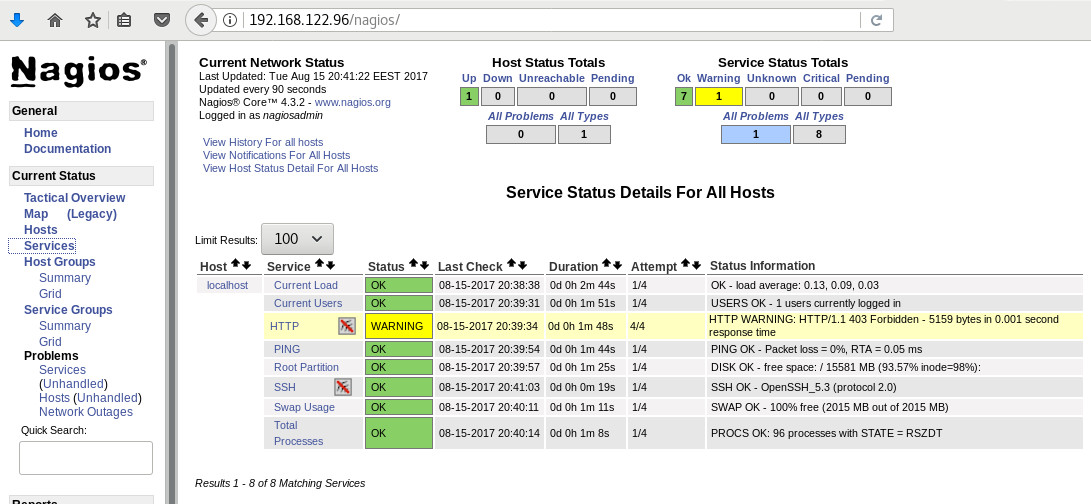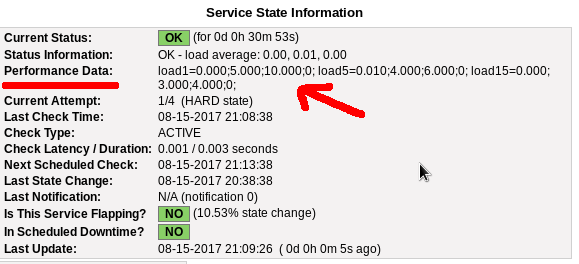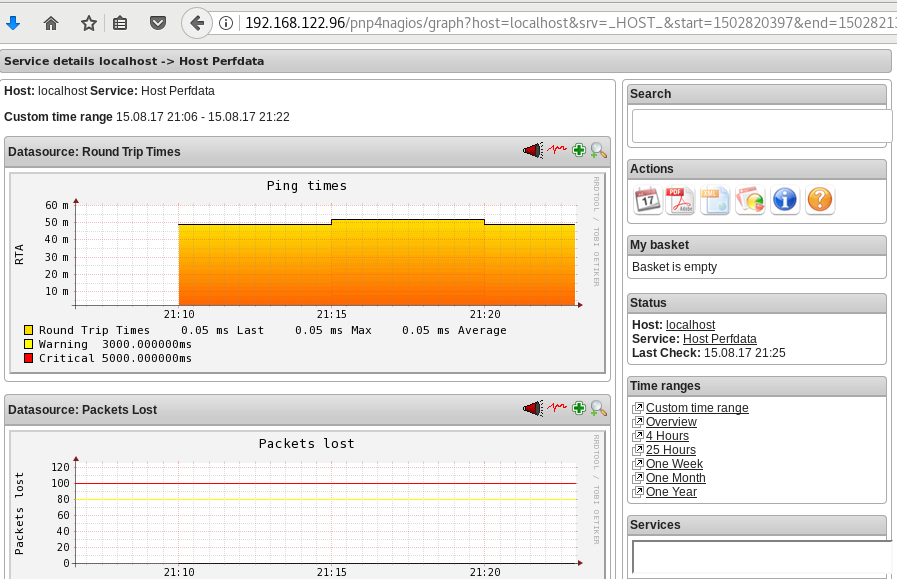![]()
In many companies, nagios is the de-facto monitoring tool. Even with new modern alternatives solutions, this opensource project, still, has a large amount of implementations in place. This guide is based on a “clean/fresh” CentOS 6.9 virtual machine.
Epel
An official nagios repository exist in this address: https://repo.nagios.com/
I prefer to install nagios via the EPEL repository:
# yum -y install http://fedora-mirror01.rbc.ru/pub/epel/6/x86_64/epel-release-6-8.noarch.rpm
# yum info nagios | grep Version
Version : 4.3.2# yum -y install nagios
Selinux
Every online manual, suggest to disable selinux with nagios. There is a reason for that ! but I will try my best to provide info on how to keep selinux enforced. To write our own nagios selinux policies the easy way, we need one more package:
# yum -y install policycoreutils-python
Starting nagios:
# /etc/init.d/nagios restart
will show us some initial errors in /var/log/audit/audit.log selinux log file
Filtering the results:
# egrep denied /var/log/audit/audit.log | audit2allow
will display something like this:
#============= nagios_t ==============
allow nagios_t initrc_tmp_t:file write;
allow nagios_t self:capability chown;
To create a policy file based on your errors:
# egrep denied /var/log/audit/audit.log | audit2allow -a -M nagios_t
and to enable it:
# semodule -i nagios_t.pp
BE AWARE this is not the only problem with selinux, but I will provide more details in few moments.
Nagios
Now we are ready to start the nagios daemon:
# /etc/init.d/nagios restart
filtering the processes of our system:
# ps -e fuwww | egrep na[g]ios
nagios 2149 0.0 0.1 18528 1720 ? Ss 19:37 0:00 /usr/sbin/nagios -d /etc/nagios/nagios.cfg
nagios 2151 0.0 0.0 0 0 ? Z 19:37 0:00 _ [nagios] <defunct>
nagios 2152 0.0 0.0 0 0 ? Z 19:37 0:00 _ [nagios] <defunct>
nagios 2153 0.0 0.0 0 0 ? Z 19:37 0:00 _ [nagios] <defunct>
nagios 2154 0.0 0.0 0 0 ? Z 19:37 0:00 _ [nagios] <defunct>
nagios 2155 0.0 0.0 18076 712 ? S 19:37 0:00 _ /usr/sbin/nagios -d /etc/nagios/nagios.cfg
super!
Apache
Now it is time to start our web server apache:
# /etc/init.d/httpd restart
Starting httpd: httpd: apr_sockaddr_info_get() failed
httpd: Could not reliably determine the server's fully qualified domain name, using 127.0.0.1 for ServerNameThis is a common error, and means that we need to define a ServerName in our apache configuration.
First, we give an name to our host file:
# vim /etc/hosts
for this guide, I ‘ll go with the centos69 but you can edit that according your needs:
127.0.0.1 localhost localhost.localdomain localhost4 localhost4.localdomain4 centos69then we need to edit the default apache configuration file:
# vim /etc/httpd/conf/httpd.conf
#ServerName www.example.com:80
ServerName centos69and restart the process:
# /etc/init.d/httpd restart
Stopping httpd: [ OK ]
Starting httpd: [ OK ]We can see from the netstat command that is running:
# netstat -ntlp | grep 80
tcp 0 0 :::80 :::* LISTEN 2729/httpd Firewall
It is time to fix our firewall and open the default http port, so that we can view the nagios from our browser.
That means, we need to fix our iptables !
# iptables -A INPUT -m state --state NEW -m tcp -p tcp --dport 80 -j ACCEPT
this is want we need. To a more permanent solution, we need to edit the default iptables configuration file:
# vim /etc/sysconfig/iptables
and add the below entry on INPUT chain section:
-A INPUT -m state --state NEW -m tcp -p tcp --dport 80 -j ACCEPTWeb Browser
We are ready to fire up our web browser and type the address of our nagios server.
Mine is on a local machine with the IP: 129.168.122.96, so
http://192.168.122.96/nagios/
User Authentication
The default user authentication credentials are:
nagiosadmin // nagiosadminbut we can change them!
From our command line, we type something similar:
# htpasswd -sb /etc/nagios/passwd nagiosadmin e4j9gDkk6LXncCdDg
so that htpasswd will update the default nagios password entry on the /etc/nagios/passwd with something else, preferable random and difficult password.
ATTENTION: e4j9gDkk6LXncCdDg is just that, a random password that I created for this document only. Create your own and dont tell anyone!
Selinux, Part Two
at this moment and if you are tail-ing the selinux audit file, you will see some more error msgs.
Below, you will see my nagios_t selinux policy file with all the things that are needed for nagios to run properly - at least at the moment.!
module nagios_t 1.0;
require {
type nagios_t;
type initrc_tmp_t;
type nagios_spool_t;
type nagios_system_plugin_t;
type nagios_exec_t;
type httpd_nagios_script_t;
class capability chown;
class file { write read open execute_no_trans getattr };
}
#============= httpd_nagios_script_t ==============
allow httpd_nagios_script_t nagios_spool_t:file { open read getattr };
#============= nagios_t ==============
allow nagios_t initrc_tmp_t:file write;
allow nagios_t nagios_exec_t:file execute_no_trans;
allow nagios_t self:capability chown;
#============= nagios_system_plugin_t ==============
allow nagios_system_plugin_t nagios_exec_t:file getattr;Edit your nagios_t.te file accordingly and then build your selinux policy:
# make -f /usr/share/selinux/devel/Makefile
You are ready to update the previous nagios selinux policy :
# semodule -i nagios_t.pp
Selinux - Nagios package
So … there is an rpm package with the name: nagios-selinux on Version: 4.3.2
you can install it, but does not resolve all the selinux errors in audit file ….. so ….
I think my way is better, cause you can understand some things better and have more flexibility on defining your selinux policy
Nagios Plugins
Nagios is the core process, daemon. We need the nagios plugins - the checks !
You can do something like this:
# yum install nagios-plugins-all.x86_64
but I dont recommend it.
These are the defaults :
nagios-plugins-load-2.2.1-4git.el6.x86_64
nagios-plugins-ping-2.2.1-4git.el6.x86_64
nagios-plugins-disk-2.2.1-4git.el6.x86_64
nagios-plugins-procs-2.2.1-4git.el6.x86_64
nagios-plugins-users-2.2.1-4git.el6.x86_64
nagios-plugins-http-2.2.1-4git.el6.x86_64
nagios-plugins-swap-2.2.1-4git.el6.x86_64
nagios-plugins-ssh-2.2.1-4git.el6.x86_64# yum -y install nagios-plugins-load nagios-plugins-ping nagios-plugins-disk nagios-plugins-procs nagios-plugins-users nagios-plugins-http nagios-plugins-swap nagios-plugins-ssh
and if everything is going as planned, you will see something like this:

PNP4Nagios
It is time, to add pnp4nagios a simple graphing tool and get read the nagios performance data and represent them to graphs.
# yum info pnp4nagios | grep Version
Version : 0.6.22# yum -y install pnp4nagios
We must not forget to restart our web server:
# /etc/init.d/httpd restart
Bulk Mode with NPCD
I’ve spent toooooo much time to understand why the default Synchronous does not work properly with nagios v4x and pnp4nagios v0.6x
In the end … this is what it works - so try not to re-invent the wheel , as I tried to do and lost so many hours.
Performance Data
We need to tell nagios to gather performance data from their check:
# vim +/process_performance_data /etc/nagios/nagios.cfg
process_performance_data=1
We also need to tell nagios, what to do with this data:
nagios.cfg
# *** the template definition differs from the one in the original nagios.cfg
#
service_perfdata_file=/var/log/pnp4nagios/service-perfdata
service_perfdata_file_template=DATATYPE::SERVICEPERFDATAtTIMET::$TIMET$tHOSTNAME::$HOSTNAME$tSERVICEDESC::$SERVICEDESC$tSERVICEPERFDATA::$SERVICEPERFDATA$tSERVICECHECKCOMMAND::$SERVICECHECKCOMMAND$tHOSTSTATE::$HOSTSTATE$tHOSTSTATETYPE::$HOSTSTATETYPE$tSERVICESTATE::$SERVICESTATE$tSERVICESTATETYPE::$SERVICESTATETYPE$
service_perfdata_file_mode=a
service_perfdata_file_processing_interval=15
service_perfdata_file_processing_command=process-service-perfdata-file
# *** the template definition differs from the one in the original nagios.cfg
#
host_perfdata_file=/var/log/pnp4nagios/host-perfdata
host_perfdata_file_template=DATATYPE::HOSTPERFDATAtTIMET::$TIMET$tHOSTNAME::$HOSTNAME$tHOSTPERFDATA::$HOSTPERFDATA$tHOSTCHECKCOMMAND::$HOSTCHECKCOMMAND$tHOSTSTATE::$HOSTSTATE$tHOSTSTATETYPE::$HOSTSTATETYPE$
host_perfdata_file_mode=a
host_perfdata_file_processing_interval=15
host_perfdata_file_processing_command=process-host-perfdata-fileCommands
In the above configuration, we introduced two new commands
service_perfdata_file_processing_command &
host_perfdata_file_processing_commandWe need to define them in the /etc/nagios/objects/commands.cfg file :
#
# Bulk with NPCD mode
#
define command {
command_name process-service-perfdata-file
command_line /bin/mv /var/log/pnp4nagios/service-perfdata /var/spool/pnp4nagios/service-perfdata.$TIMET$
}
define command {
command_name process-host-perfdata-file
command_line /bin/mv /var/log/pnp4nagios/host-perfdata /var/spool/pnp4nagios/host-perfdata.$TIMET$
}If everything have gone right … then you will be able to see on a nagios check something like this:

Verify
Verify your pnp4nagios setup:
# wget -c http://verify.pnp4nagios.org/verify_pnp_config
# perl verify_pnp_config -m bulk+npcd -c /etc/nagios/nagios.cfg -p /etc/pnp4nagios/ NPCD
The NPCD daemon (Nagios Performance C Daemon) is the daemon/process that will translate the gathered performance data to graphs, so let’s started it:
# /etc/init.d/npcd restart
Stopping npcd: [FAILED]
Starting npcd: [ OK ]You should see some warnings but not any critical errors.
Templates
Two new template definition should be created, one for the host and one for the service:
/etc/nagios/objects/templates.cfg
define host {
name host-pnp
action_url /pnp4nagios/index.php/graph?host=$HOSTNAME$&srv=_HOST_' class='tips' rel='/pnp4nagios/index.php/popup?host=$HOSTNAME$&srv=_HOST_
register 0
}
define service {
name srv-pnp
action_url /pnp4nagios/graph?host=$HOSTNAME$&srv=$SERVICEDESC$' class='tips' rel='/pnp4nagios/popup?host=$HOSTNAME$&srv=$SERVICEDESC$
register 0
}Host Definition
Now we need to apply the host-pnp template to our system:
so this configuration: /etc/nagios/objects/localhost.cfg
define host{
use linux-server ; Name of host template to use
; This host definition will inherit all variables that are defined
; in (or inherited by) the linux-server host template definition.
host_name localhost
alias localhost
address 127.0.0.1
}
becomes:
define host{
use linux-server,host-pnp ; Name of host template to use
; This host definition will inherit all variables that are defined
; in (or inherited by) the linux-server host template definition.
host_name localhost
alias localhost
address 127.0.0.1
}Service Definition
And we finally must append the pnp4nagios service template to our services:
srv-pnp
define service{
use local-service,srv-pnp ; Name of service template to use
host_name localhostGraphs
We should be able to see graphs like these:

Happy Measurements!
appendix
These are some extra notes on the above article, you need to take in mind:
Services
# chkconfig httpd on
# chkconfig iptables on
# chkconfig nagios on
# chkconfig npcd on PHP
If you are not running the default php version on your system, it is possible to get this error msg:
Non-static method nagios_Core::SummaryLink()There is a simply solution for that, you need to modify the index file to exclude the deprecated php error msgs:
# vim +/^error_reporting /usr/share/nagios/html/pnp4nagios/index.php
// error_reporting(E_ALL & ~E_STRICT);
error_reporting(E_ALL & ~E_STRICT & ~E_DEPRECATED);
SCAM
Τον τελευταίο καιρό, όλο και περισσότερα email με το παρακάτω (ή παρόμοιο) body φτάνουν στο mailbox μου.
Οι περισσότεροι από εσάς, εύκολα θα διαπιστώσετε πως το παρακάτω είναι google translate, άλλοι πάλι όχι με μια πρώτη ματιά.
Be careful
Είναι, λοιπόν, ένα SCAM email, που προσπαθεί να σας ψαρέψει τα στοιχεία.
Π Ο Τ Ε καμία εταιρεία (πάροχος ή τράπεζα) δεν πρόκειται να σας ζητήσει μέσω email τα στοιχεία σας.
για αυτό Μ Η Ν απαντάτε ΠΟΤΕ σε emails της παρακάτω μορφής.
Actions
Το καλύτερο που έχετε να κάνετε, είναι να προωθήσετε ΑΜΕΣΩΣ το παρακάτω email στο abuse department της εταιρείας σας.
Μπορείτε να βοηθήσετε στην καταπολέμηση της εξάπλωσης αυτού του scam.
Abuse
Τα εκάστοτε abuse departments έχουν εργαλεία που καταγράφουν αυτές τις απόπειρες “ψαρέματος” κι εντοπίζουν τα μολυσμένα PC ή compromised accounts
Με ένα γρήγορο online search βρίσκουμε πολύ γρήγορα μερικά από τα παρακάτω abuse email addresses:
abuse@cosmote.gr
abuse@ote.gr
abuse@forthnet.gr
abuse@wind.gr
abuse@hq.cyta.gr
abuse@hol.gr
postmaster@hol.gr
abuse@nbg.gr
abuse@alpha.gr
support@winbank.grInform Other People
Το καλύτερο που έχετε να κάνετε, είναι να μιλήσετε με τους ανθρώπους του κύκλου σας και να τους ενημερώσετε σχετικά με αυτό.
Μην ξεχνάτε πως εάν τους “χακέψουν” πολύ πιθανά να έχουν στους υπολογιστές τους, δικά σας στοιχεία (από την αποθηκευμένη ατζέντα επαφών)
ή (μερική) πρόσβαση στα email που τους έχετε στείλει κι εσείς.
Οπότε, προστατεύοντάς τους, προστατεύεται και τον εαυτό σας!!
Body
παρακάτω, ένα ενδεικτικό δείγμα. Μπορεί το κείμενο να δείχνει σε άλλο πάροχο ή σε κάποια τράπεζα.
Να έχει κάποιο σύνδεσμο, στον οποίο να πρέπει να πατήσει κάποιος και να συμπληρώσει τα στοιχεία του
ή κάποια φόρμα επικοινωνίας.
Μην ξεχνάτε: Π Ο Τ Ε δεν πρέπει να δίνουμε τα στοιχεία μας, όταν βλέπουμε τέτοια emails.
Cosmote υπηρεσία OTEnet Mail
Μετά την αυτόματη ανανέωση της εγγραφή® σας το διακομιστής αντιμετώπισε κάποια λάθη να μην απαριθμήσω διεύθυνση σας.
Σας ενημερώνουμε ότι δεν μπορείτε να αποκτήσετε πρόσβαση στο λογαριασμό σας! Ή χρησιμοποιήστε το σχετικό προφίλ
αν δεν αναγνωρίσετε τον εαυτό σας σύμφωνα με τους κανονισμούς μας. Παρακαλώ μέσα σε 72 ώρες για να επιβεβαιώσετε
τη διεύθυνση ηλεκτρονικού ταχυδρομείου σας OTEnet Mail, καθώς και όλες τις πληροφορίες που ζητούνται μέσω της παρακάτω φόρμας.
ΕΠΙΒΕΒΑΙΩΣΗ ΤΟΥ ΕΝΤΥΠΟΥ (κάντε κλικ απάντηση και διαβιβάζει τα στοιχεία σας στην υπηρεσία επιβεβαίωσης στη συνέχεια αποστολή)
όνομα:........................
Όνομα:........................
Στοιχεία σύνδεσης (Απαιτείται)
Email OTEnet! :........................
κωδικό πρόσβασης:........................
Εναλλακτικές Email:........................
κωδικό πρόσβασης:........................
χώρα:........................
Ταχυδρομικός κώδικας:........................
τηλέφωνο:........................
Σημείωση: Σε περίπτωση έλλειψης των πληροφοριών που ζητούνται γνωρίζετε ότι αυτό θα διαγράψει οριστικά τη διεύθυνση ηλεκτρονικού ταχυδρομείου σας.
Με εκτίμηση.